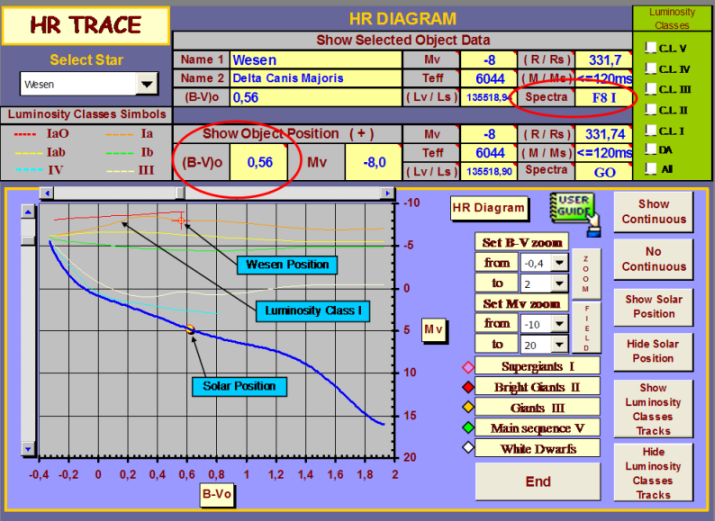Distance through Spectroscopy and Photometry
When a star is too far away
to have its distance measured directly through a geometrical method such as
trigonometric parallax, we can obtain its approximate distance indication using
spectroscopy and photometry methods together,
Taking a star spectrum one obtains:
While using photometry we can obtain for the same star:
At this point and knowing the star's spectral type and its luminosity class from the spectroscopic side plus its color index from photometric side, we can represent this point on HR diagram to infer absolute magnitude and from this last value, calculate an approximate star's distance modulus.
Wesen Example
We see all this with an example taking in consideration Wesen = Delta Canis Majoris. Wesen data are: spectral type = F8 and luminosity class = Ia, while its apparent magnitude through a Johnson V colour filter is V = 1.842.
Accounting for Wesen Extinction
To find the Wesen true colour is a very simple question since we know its spectral classification. So, using the Schmidt-Kaler intrinsic colors calibration we can easily find the true colour for this star as equal to B-V = 0.56 for an F8 Ia supergiant.
Positioning Wesen on HR Diagram
Using now the Herzprung-Russel diagram, we can place Wesen over the B-V = 0.56 colour index vertical line and constrain further its position on the trak equivalent to luminosity class I. Once placed Wesen in this manner, we can infer its absolute magnitude that will be approximately Mv = - 8 see at this purpose the following figure 1.

Fig. 1 - Absolute magnitude of Wesen inferred from its position over HR diagram.
How to obtain Wesen distance
To calculate Wesen distance in parsec we use: ( m - M ) = 5Log( d/10 ), as follow:
d = 10 (m - M + 5 ) / 5
Now substituting numerical values
d = 10 [ (1.,842 - (- 8) + 5 ] / 5
d = 10 14.842 / 5
d = 10 2.9684
d = approx 930 parsec
© 2006 - Valter Arnò.